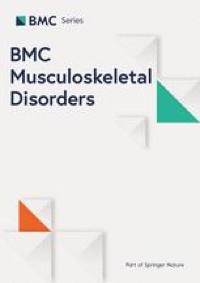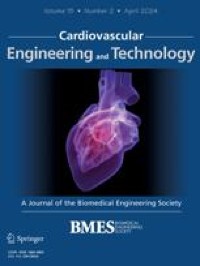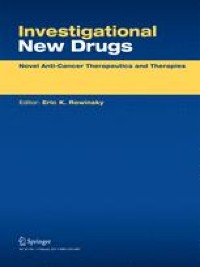|
Αρχειοθήκη ιστολογίου
-
►
2023
(391)
- ► Φεβρουαρίου (200)
- ► Ιανουαρίου (191)
-
▼
2022
(2843)
- ► Δεκεμβρίου (161)
- ► Σεπτεμβρίου (219)
-
▼
Μαρτίου
(314)
-
▼
Μαρ 16
(22)
- An enhanced recovery after surgery pathway: LOS re...
- Role of drug delivery technologies in the success ...
- ECG Signal Quality Assessments of a Small Bipolar ...
- Embedded Computational Heart Model for External Ve...
- Portable ultrasound assessment of jugular venous p...
- Actively targeted delivery of SN38 by ultrafine ir...
- Synthetic fused sRNA for the simultaneous repressi...
- Protective effects of interleukin-22 on oxalate-in...
- Increased migratory activity and cartilage regener...
- The Ali Krogius procedure for treatment of patello...
- Acute cardiac autonomic and haemodynamic responses...
- The time course of different neuromuscular adaptat...
- How I do it: endonasal transcribriform approach fo...
- Enhancement of radiation response of breast cancer...
- Gastric duplication cyst: a challenging EUS differ...
- Type I interferon-mediated tumor immunity and its ...
- Protective Performance of Helmets and Goggles in M...
- Real-time eye state recognition using dual convolu...
- The role of DHCR24 in the pathogenesis of AD: re-c...
- Microglia phenotypes are associated with subregion...
- Colocalization of Coronary Plaque with Wall Shear ...
- Laser‐Assisted Sialolithotripsy: A Correlation of ...
-
▼
Μαρ 16
(22)
- ► Φεβρουαρίου (264)
- ► Ιανουαρίου (280)
-
►
2021
(5625)
- ► Δεκεμβρίου (231)
- ► Σεπτεμβρίου (345)
- ► Φεβρουαρίου (620)
-
►
2020
(2065)
- ► Δεκεμβρίου (535)
- ► Σεπτεμβρίου (222)
- ► Φεβρουαρίου (28)
-
►
2019
(9608)
- ► Δεκεμβρίου (19)
- ► Σεπτεμβρίου (54)
- ► Φεβρουαρίου (3791)
- ► Ιανουαρίου (3737)
-
►
2018
(69720)
- ► Δεκεμβρίου (3507)
- ► Σεπτεμβρίου (3851)
- ► Φεβρουαρίου (8116)
- ► Ιανουαρίου (7758)
-
►
2017
(111579)
- ► Δεκεμβρίου (7718)
- ► Σεπτεμβρίου (7549)
- ► Φεβρουαρίου (10753)
- ► Ιανουαρίου (10529)
-
►
2016
(16402)
- ► Δεκεμβρίου (7478)
- ► Φεβρουαρίου (900)
- ► Ιανουαρίου (1250)
! # Ola via Alexandros G.Sfakianakis on Inoreader
Η λίστα ιστολογίων μου
Τετάρτη 16 Μαρτίου 2022
An enhanced recovery after surgery pathway: LOS reduction, rapid discharge and minimal complications after anterior cervical spine surgery
Role of drug delivery technologies in the success of COVID-19 vaccines: a perspective
|
ECG Signal Quality Assessments of a Small Bipolar Single-Lead Wearable Patch Sensor
|
Embedded Computational Heart Model for External Ventricular Assist Device Investigations
|
Portable ultrasound assessment of jugular venous pressure is an accurate method for estimating volaemic status in patients with cardiac disease
|
Actively targeted delivery of SN38 by ultrafine iron oxide nanoparticle for treating pancreatic cancer
|
Synthetic fused sRNA for the simultaneous repression of multiple genes
|
Protective effects of interleukin-22 on oxalate-induced crystalline renal injury via alleviating mitochondrial damage and inflammatory response
|
Increased migratory activity and cartilage regeneration by superficial-zone chondrocytes in enzymatically treated cartilage explants
|
The Ali Krogius procedure for treatment of patellofemoral instability should be regarded as obsolete even in skeletally immature patients
|
Acute cardiac autonomic and haemodynamic responses to leg and arm isometric exercise
|
Αρχειοθήκη ιστολογίου
-
►
2023
(391)
- ► Φεβρουαρίου (200)
- ► Ιανουαρίου (191)
-
▼
2022
(2843)
- ► Δεκεμβρίου (161)
- ► Σεπτεμβρίου (219)
-
▼
Μαρτίου
(314)
-
▼
Μαρ 16
(22)
- An enhanced recovery after surgery pathway: LOS re...
- Role of drug delivery technologies in the success ...
- ECG Signal Quality Assessments of a Small Bipolar ...
- Embedded Computational Heart Model for External Ve...
- Portable ultrasound assessment of jugular venous p...
- Actively targeted delivery of SN38 by ultrafine ir...
- Synthetic fused sRNA for the simultaneous repressi...
- Protective effects of interleukin-22 on oxalate-in...
- Increased migratory activity and cartilage regener...
- The Ali Krogius procedure for treatment of patello...
- Acute cardiac autonomic and haemodynamic responses...
- The time course of different neuromuscular adaptat...
- How I do it: endonasal transcribriform approach fo...
- Enhancement of radiation response of breast cancer...
- Gastric duplication cyst: a challenging EUS differ...
- Type I interferon-mediated tumor immunity and its ...
- Protective Performance of Helmets and Goggles in M...
- Real-time eye state recognition using dual convolu...
- The role of DHCR24 in the pathogenesis of AD: re-c...
- Microglia phenotypes are associated with subregion...
- Colocalization of Coronary Plaque with Wall Shear ...
- Laser‐Assisted Sialolithotripsy: A Correlation of ...
-
▼
Μαρ 16
(22)
- ► Φεβρουαρίου (264)
- ► Ιανουαρίου (280)
-
►
2021
(5625)
- ► Δεκεμβρίου (231)
- ► Σεπτεμβρίου (345)
- ► Φεβρουαρίου (620)
-
►
2020
(2065)
- ► Δεκεμβρίου (535)
- ► Σεπτεμβρίου (222)
- ► Φεβρουαρίου (28)
-
►
2019
(9608)
- ► Δεκεμβρίου (19)
- ► Σεπτεμβρίου (54)
- ► Φεβρουαρίου (3791)
- ► Ιανουαρίου (3737)
-
►
2018
(69720)
- ► Δεκεμβρίου (3507)
- ► Σεπτεμβρίου (3851)
- ► Φεβρουαρίου (8116)
- ► Ιανουαρίου (7758)
-
►
2017
(111579)
- ► Δεκεμβρίου (7718)
- ► Σεπτεμβρίου (7549)
- ► Φεβρουαρίου (10753)
- ► Ιανουαρίου (10529)
-
►
2016
(16402)
- ► Δεκεμβρίου (7478)
- ► Φεβρουαρίου (900)
- ► Ιανουαρίου (1250)







